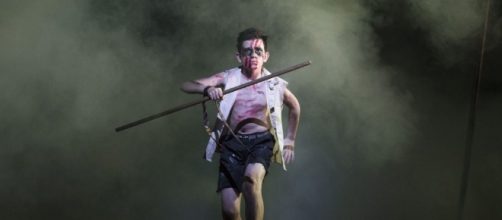"What are we? Humans? Or animals? Or savages?"
In the middle of an evacuation, a British airplane crashes on a remote inland in the Pacific Ocean. The survivors are boys, between 10 and 12. No adults are present and so the boys must rule themselves without the taming softness of woman's hand or an adult's vision.
"We've got to have rules and obey them. After all, we're not savages."
Piggy is an overweight boy with poor vision while Ralph is the one to whom all must aspire to be, a blonde-haired child endowed with kindness and fair play. Jack and Piggy head to the beach where they discover a conch shell which becomes an almost religious icon used to bring the boys together.
Ralph becomes the keeper the shell and thereafter their leader. Ralph appoints Jack to be in charge of the hunt for food.
Ralph, Jack, and Simon, set off to discover the island. Ralph decides a signal fire must be lighted to alert passing ships to their location. They use Piggy's eye glasses to start the fire but because boys like to play they don't see that the fire has burned out of control. An entire forest is burned to the ground before it stops. Sadly, one of the boys is missing and presumed dead.
"Maybe there is a beast. Maybe it is us."
The group begins to believe there is a monster alive on the island. It comes from the sea and Jack and Ralph see it flapping in the wind and hear the horrific sound of its guttural voice.
It is nothing but a parachute that brought a dead man to the island after his plane was shot down when the boys were asleep. But, boys will be boys and a monster it is.
Jack believes Ralph's inability to face the monster is a cowardly act. He demands Ralph be removed as head of the group. Most of the boys refuse and Jack takes his hunters and leaves, forming his own group on the other side of the forest. The hunters organize a religious-like ritual that ends with the death of a sow. The hunters cut off the pigs head and place it on a stake, creating an object of worshipful adoration and a bite to eat for the monster that lives in the forest.
"Fancy thinking the Beast was something you could hunt and kill! You knew, didn't you? I'm part of you?"
Simon hears the voice of the monster after he sees the fly-covered head of the sow. He names the monster Lord of the Flies. The lord tells Simon that no one can ever escape him, that the Lord of the Flies lives within every man. When Simon rushes back to the boys to tell them what he's discovered, the boys fall on him and kill him with their hands and teeth. When the boys are eventually found, an Englishman asks, what has happened to turn them into savages? When confronted with a civilized person, the mask of violence and fear the boys have been hiding behind falls from their faces. They cannot answer and instead turn to tears.
It is too much for them to bear and far too much for them to understand.
The by-product of fear
The Lord of the Flies is a allegory representing conflicting emotions in human beings. There is the need and the want to act by rules. To be seen as fair and to be filled with justice, while at the same time violence hides just below the surface waiting for the right circumstances to be freed.
Savagery and its actions are by-products of fear. The breakdown of civilization and social order is fraught with danger. As some become leaders it is not expected that they be filled with justice and good intention. It is only necessary that they become judge and executioner. This can be accomplished with gentleness and groupthink just as easily as it can with violence.
In Lord of the Flies that power is the ability to kill and survive, the only law being the one of the jungle. And that is the way it stays, until civilization steps in.
It is good to remember these words: "What I mean is...maybe it's only us..."

